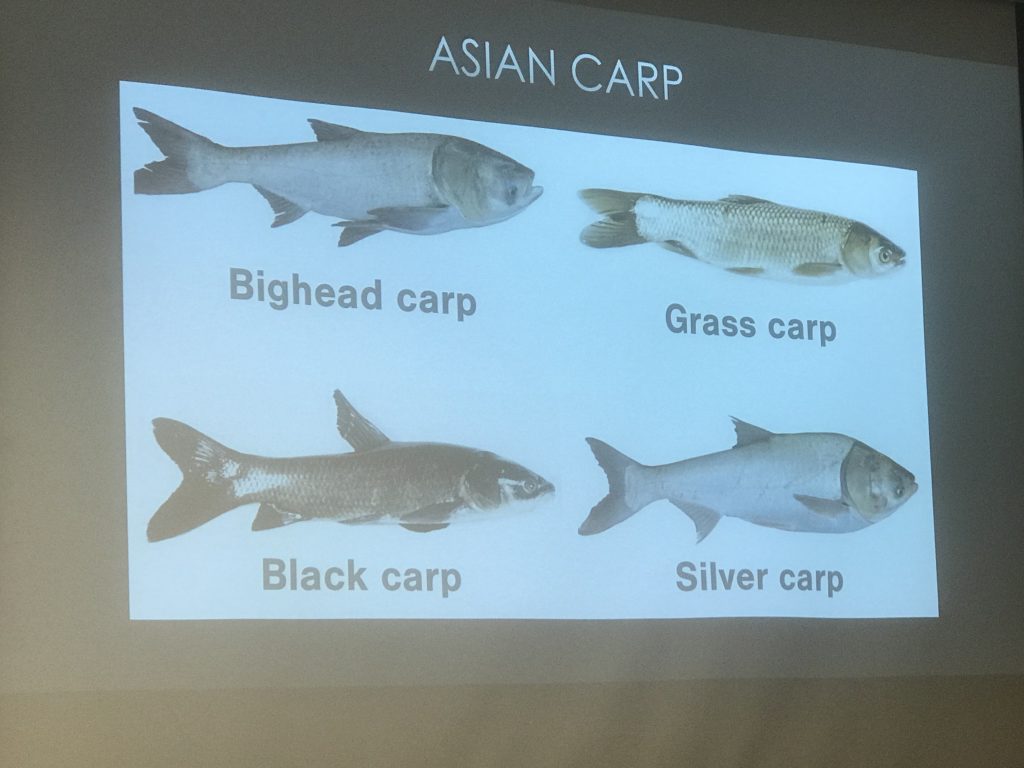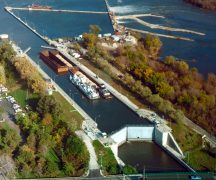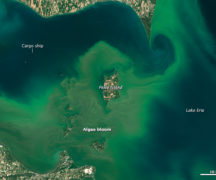By DAVID DUPONT
BG Independent News
The danger posed by the invasion of Asian carp came to Shannon Orr like a slap in the face, or in the case of her daughter, literally a slap in the face.
Two years ago when Orr, who teaches public policy at Bowling Green State University, was first starting work on her book on Asian carp, her husband gave her the “best birthday present” —a trip to go bow hunting fo Asian carp.
So the family of three headed to a river in Indiana.
They were given bows and arrows. As the boat pulled away from the dock the river was calm. Then their guide sped up.
The river exploded with leaping silver carp for as far as they could see. They were surrounded by leaping fish.
One smacked her 9-year-old daughter right in the face. She was pleased she’d caught one.
Orr’s husband was able to take two out of the air with the bow. “The greatest warrior moment ever,” she quipped.
Orr and her daughter used nets. They didn’t even have to scoop them into the water, the fish just leaped into them. Within an hour they had filled a garbage can with fish, which their guide would use as compost. That’s pretty much all the fish are good for.
“This to me summed up the danger of Asian carp,” Orr said during her presentation “Holy Carp” Monday as a kick off to Sustainability Week at BGSU.
This was a river that had been filled with native fish, and the guy who was doing the Asian carp hunt had been a fisherman. Asian carp arrived in river and pushed out the native fish and ruined his livelihood. He came up with this idea of the Asian carp hunt.
The guide told Orr that the carp invasion had devastated the community that had depended on tourism.
People would come to fish, boat and water ski. Now that has all gone away.
“Local stores, restaurants, rental properties and campgrounds that can no longer sustain themselves because of a fish,” Orr said.

Those fish threaten to destroy the ecosystem of the Great Lakes if they get established there, and they are as near as 10 miles away.
The Great Lakes face the danger of harmful algae blooms and pollution, but some experts, she said, believe Asian carp pose the most serious threat. They eat the plankton and other food that other species rely on at various points in their life cycle.
They are highly fertile. One female can carry a million eggs. They have no natural predators.
Like the carp hunting guide, concerned parties are trying to tap their creativity to address the problem.
The invasion began in the 1970s. Fish farmers in the South, with the blessing of federal and state authorities, imported a few hundred. They were brought in to eat the algae clogging the ponds.
The fish were considered a green alternative to herbicides. They weren’t supposed to leave the ponds.
“No one ever told the fish that,” Orr said.
Floods came, especially in Arkansas.
Some fish escaped. But scientists said they wouldn’t survive. They did. Nor would they breed. They did. Nor would they migrate. They did, and continue to do so.
Now they are knocking on the door of Lake Michigan. “They’ve been having this devastating impact on communities, rivers, and lakes along the way,” Orr said.
They are in the Chicago River. A canal separates them from Lake Michigan.
Keeping them out is the rare issue without a partisan divide. That’s not to say there isn’t controversy.
Electric fields inside the canal have been used. But what happens if the power goes out. And when a metal boat goes through it disrupts the current, allowing a fish to swim below the hull.
Curtains of roiling, bubbling water are also being tried.
But some people from Canada and other Great Lakes states are pressing for the construction of a solid barrier. That would cost billions and disrupt the barge trade that hauls manufactured goods from inland to be shipped.
The change would also mean reversing the course of the canal.
Illinois officials, Orr said, argue that the barrier would be too much of an economic burden.
And during the years it would take to engineer and build, it’s possible the carp would make their way to Lake Michigan anyway, rendering the project useless.
The State of Illinois is subsidizing a processing industry that would increase demand for carp by turning it into fertilizer, fish oil or dog treats.
Some have suggested increasing the demand for human consumption. One chef, Orr said, brought in a batch of fish, but there was so little flesh on its boney frame that he would have to charge as much for the fish as he does for lobster. And it doesn’t have that much flavor.
The carp are eaten in Asia, but as balls and cakes, not a common entree here.
Holly Myers, a senior lecturer in environmental justice, noted that in Asia there are river dolphins that serve as a natural predator, and the rivers are more polluted.
Orr said that at times officials have resorted to poisoning the fish, but that kills a lot more than carp. Dredging them up has also been tried, but again that results in collateral damage to other species.
Scientists are at work on poisons that would specifically target the carp.
Lots of people are working on new technologies, but nothing has yet come to fruition, she said.
And the carp have defied the odds already. They survived, bred, and migrated when they weren’t supposed to. They are a success story in a way, she said.
Orr said that they also pose a political problem.
“How do you get people excited about a fish?”
How do officials spur people to action over something that may or may not happen and will cost billions of dollars? “No one’s going to die,” she said of the Asian carp.
The Great Lakes region has so many problems not just environmental but the opioid epidemic and poverty.
But the entire ecosystem of the Great Lakes is at stake, and the livelihoods of those in the sports and tourism industry.
There are competing compelling interests, Orr said. She finds herself flip flopping on what should be done.
So whenever she can she gives public talks like this to spell out problem, and the choices that will have to be made.
“How do you justify spending billions of dollars to stop a fish? It’s not an easy decision.”





